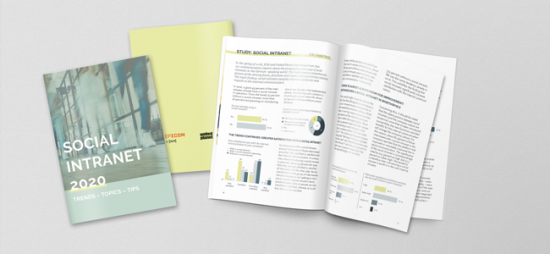A new intranet should be put in place: modern, interactive and sprinkled with social functions. Just like in their private lives, staff should be able to communicate without complications – and this via channels that are well organized and data protection compliant. But what should you do if management can’t be brought on board as early adopters?
Every digital platform hinges on the community that is actively using it. Making it even more important that management sets an example and has a strong presence on the platform. The reality looks quite different, however: “If need be, give the people their games.” … “Our competitors have got one so we need one as well.” … “But what if the people get distracted from their work?” – all sentences that in one way or another have probably been spoken in some executive board meetings.
Not all board members and managers have yet realized why the new social intranet makes sense from a business perspective. This is even more problematic when the private media usage doesn’t match the communication habits of the well-trained, eager young generation of employees, which the company is trying to attract. But there are good reasons for management to actively engage in using the social intranet: they can greatly benefit from digital communications.
Talking to each other: effective communication between management
First, a social intranet with its collaboration functions can be conducive to better, faster, location-independent – in short, more effective – communication among management. Additionally, managers can in some cases sharpen up their own social media competencies and expand their understanding of modern media usage behavior. This holds great potential to get closer to their own staff on the one hand and their external target groups on the other hand.
Transparent speech: create digital understanding
Even more important than simplified communication between managers, however, is the qualitative boost to the communication with employees: via video formats, chats in real-time and transparency concerning their own work, they can get in contact with staff in a tangible and almost personal manner. This promises – if used adequately – a motivational boost for all involved and also revolutionizes the possibilities of a positive feedback culture in the company. A social intranet can actively accompany the cultural change in the company on the way to a new working world.
Close to the pulse: valuable insights into the inner workings of the company
Another pivotal aspect is the ability to gain an insight into the inner workings of the company. Especially for management, clarity about the challenges, concerns and hardships – as well as successes – of employees is indispensable. A social intranet equips them with a powerful tool to this end. With just a few clicks, managers can determine at which site and in which department their skills are particularly needed, where they need to make readjustments. Conversely, employees can straightforwardly fulfill their information obligation towards their managers.
Set an example: how managers can create digital opportunities
It’s worth it, therefore, to set an example for staff. The boss with his/her own profile page in the social network can have a big impact on the company: When employees can read what their superiors have got on their agenda today, and how things are in the company, then this creates closeness. This allows them to directly show employees that everyone in the company is pulling together. Emerging conflicts can be defused proactively as closeness leads to understanding.
About the author
 Philipp Bahrt, Head of internal communications
Philipp Bahrt, Head of internal communications
Philipp Bahrt is head of internal communications at SCM – School for Communication and Management. He is chief editor of the trade magazine “BEYOND” and works on various topics related to digital transformation and its significance for cooperation within organizations within the scope of lectures, technical contributions and studies. The postgraduate economist is particularly interested in the points of intersection of efficient organizational structures and appreciative, inclusive communication.









